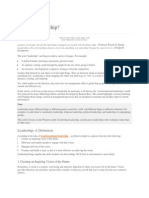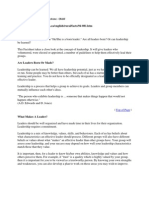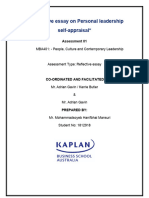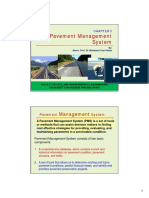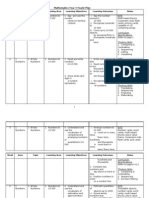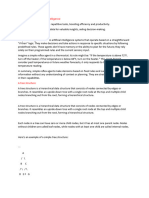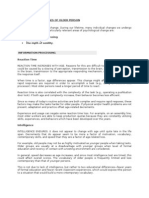Evaluation of The Leadership Qualities of The Project Manager
Evaluation of The Leadership Qualities of The Project Manager
Uploaded by
Kavi MaranCopyright:
Available Formats
Evaluation of The Leadership Qualities of The Project Manager
Evaluation of The Leadership Qualities of The Project Manager
Uploaded by
Kavi MaranOriginal Description:
Original Title
Copyright
Available Formats
Share this document
Did you find this document useful?
Is this content inappropriate?
Copyright:
Available Formats
Evaluation of The Leadership Qualities of The Project Manager
Evaluation of The Leadership Qualities of The Project Manager
Uploaded by
Kavi MaranCopyright:
Available Formats
1.
Evaluation of the leadership qualities of the project manager What qualities are most important for a project manager to be an effective project leader? It's a question often asked and one that makes us sit back and think. Over the past few years, the people at ESI International, a leader in project management training, have looked at what makes an effective project leader. They quizzed some highly-talented project leaders and compiled a running tally of their responses. Below are the top 10 qualities in rank order, according to their frequency listed. Inspires a Shared Vision An effective project leader is often described as having a vision of where to go and the ability to articulate it. Visionaries thrive on change and being able to draw new boundaries. It was once said that a leader is someone who "lifts us up, gives us a reason for being and gives the vision and spirit to change." Visionary leaders enable people to feel they have a real stake in the project. They empower people to experience the vision on their own. According to Bennis "They offer people opportunities to create their own vision, to explore what the vision will mean to their jobs and lives, and to envision their future as part of the vision for the organization." (Bennis, 1997) A Good Communicator The ability to communicate with people at all levels is almost always named as the second most important skill by project managers and team members. Project leadership calls for clear communication about goals, responsibility, performance, expectations and feedback. There is a great deal of value placed on openness and directness. The project leader is also the team's link to the larger organization. The leader must have the ability to effectively negotiate and use persuasion when necessary to ensure the success of the team and project. Through effective communication, project leaders support individual and team achievements by creating explicit guidelines for accomplishing results and for the career advancement of team members. Integrity One of the most important things a project leader must remember is that his or her actions, and not words, set the modus operandi for the team. Good leadership demands commitment to, and demonstration of, ethical practices. Creating standards for ethical behavior for oneself and living by these standards, as well as rewarding those who exemplify these practices, are responsibilities of project leaders. Leadership motivated by self-interest does not serve the well being of the team. Leadership based on integrity represents nothing less than a set of values others share, behavior consistent with values and dedication to honesty with self and team members. In other words the leader "walks the talk" and in the process earns trust.
Enthusiasm Plain and simple, we don't like leaders who are negative - they bring us down. We want leaders with enthusiasm, with a bounce in their step, with a can-do attitude. We want to believe that we are part of an invigorating journey - we want to feel alive. We tend to follow people with a cando attitude, not those who give us 200 reasons why something can't be done. Enthusiastic leaders are committed to their goals and express this commitment through optimism. Leadership emerges as someone expresses such confident commitment to a project that others want to share his or her optimistic expectations. Enthusiasm is contagious and effective leaders know it. Empathy What is the difference between empathy and sympathy? Although the words are similar, they are, in fact, mutually exclusive. According to Norman Paul, in sympathy the subject is principally absorbed in his or her own feelings as they are projected into the object and has little concern for the reality and validity of the object's special experience. Empathy, on the other hand, presupposes the existence of the object as a separate individual, entitled to his or her own feelings, ideas and emotional history (Paul, 1970). As one student so eloquently put it, "It's nice when a project leader acknowledges that we all have a life outside of work." Competence Simply put, to enlist in another's cause, we must believe that that person knows what he or she is doing. Leadership competence does not however necessarily refer to the project leader's technical abilities in the core technology of the business. As project management continues to be recognized as a field in and of itself, project leaders will be chosen based on their ability to successfully lead others rather than on technical expertise, as in the past. Having a winning track record is the surest way to be considered competent. Expertise in leadership skills is another dimension in competence. The ability to challenge, inspire, enable, model and encourage must be demonstrated if leaders are to be seen as capable and competent. Ability to Delegate Tasks Trust is an essential element in the relationship of a project leader and his or her team. You demonstrate your trust in others through your actions - how much you check and control their work, how much you delegate and how much you allow people to participate. Individuals who are unable to trust other people often fail as leaders and forever remain little more that micromanagers, or end up doing all of the work themselves. As one project management student put it, "A good leader is a little lazy." An interesting perspective!
Cool Under Pressure In a perfect world, projects would be delivered on time, under budget and with no major problems or obstacles to overcome. But we don't live in a perfect world - projects have problems. A leader with a hardy attitude will take these problems in stride. When leaders encounter a stressful event, they consider it interesting, they feel they can influence the outcome and they see it as an opportunity. "Out of the uncertainty and chaos of change, leaders rise up and articulate a new image of the future that pulls the project together." (Bennis 1997) And remember - never let them see you sweat. Team-Building Skills A team builder can best be defined as a strong person who provides the substance that holds the team together in common purpose toward the right objective. In order for a team to progress from a group of strangers to a single cohesive unit, the leader must understand the process and dynamics required for this transformation. He or she must also know the appropriate leadership style to use during each stage of team development. The leader must also have an understanding of the different team players styles and how to capitalize on each at the proper time, for the problem at hand. Problem Solving Skills An efficient project manager should be capable of solving any or all problems, either with the team or the project itself. The team members should trust them to solve their problems but also involve the team in problem solving also.
http://2020projectmanagement.com/2013/04/top-10-qualities-of-a-project-manager/
3. The motivation techniques used Managers everywhere want teams that are effective, focused, and committed to organizational goals.With a team like this, just think of the performance and results you could deliver!Teams only perform like this if their managers are motivating them effectively. This is why you need to be able to motivate your team if you want to create a productive work environment. By combining good motivational practices with meaningful work, the setting of performance goals, and use of an effective reward system, you can establish the kind of atmosphere and culture that you need to excel. The better you are able to link these factors together, the higher the motivation levels of your team are likely to be. That's a win-win for you, them, and the organization.
Providing Productive and Challenging Work The first step in building a highly motivated team is providing interesting work, which is well organized to meet the needs and desires of team members. No matter how self-motivated a person is, how challenging the goals he or she sets, or how wonderful the rewards, if the work is badly designed, it will be hard to motivate people and work will be less than ideal. Effective motivators understand that work design has a strong impact on performance. When a person finds a job inherently unsatisfying, there's not much you can do to motivate him or her. Job design and enrichment combine to match characteristics of the job with workers' skills and interests: The more variety, challenge and autonomy there is to a job, the more intrinsically satisfying it will be. Setting Effective Goals When you are confident that the work you provide is well organized, the next thing to do is to ensure that workers have clear and attainable goals that they're working to achieve. Managing the goal setting process is essential for creating a highly motivating environment. The effectiveness of goal setting in motivation is a well-recognized fact, and by making goals specific, consistent, and appropriately challenging, you can set goals that are powerfully motivating. As such, the SMART (Specific, Measurable, Attainable, Relevant, Time-bound) acronym helps you define effective goals. Specific goals are measurable, unambiguous and behavior-changing. They outline exactly what needs to be accomplished, and when it will be considered as "achieved". Having goals that are consistent with other personal goals as well as organizational goals is also important. If goals are inconsistent, the resulting confusion and incompatibility would like cause the person to do nothing rather than work in different directions.
Understanding Individual Differences in Motivation Motivational techniques should bring out the best in people. That means they should build on an individual's strengths and minimize his or her weaknesses.
There are certainly some common denominators in motivation, like fair wages, decent working conditions, a sense of camaraderie with co-workers, and a good relationship with ones supervisor. Abraham Maslow and Frederick Herzberg are two famous motivation theorists who established that even if these sorts of things are not necessarily motivating in themselves, they have to be present in order to even think about enhancing motivation. However, the assumption in most modern workplaces is that these lower order, "hygiene" factors are being met, and that people are seeking the things that provide real motivation. These are things like challenging work, control, growth opportunities, and recognition for a job well done. To decide which motivating factors to provide you need to look at the individual employees. Some will be motivated by more time off, while others may prefer to gain status and recognition in the company. Understanding these individual needs is mandatory for building a motivating workplace, and is why question 11 above is a "trick question": if you try to motivate everyone in exactly the same way, you're likely missing plenty of opportunities for motivating individual members of your team. Providing Rewards and Recognition When you know what you want to provide in terms of reward and recognition, it's important to establish an effective system. The primary focus of a reward system is fairness. Both reward and discipline have to be perceived as fairly distributed according to clear guidelines. This is why setting specific performance expectations is so important. It is equally important to make sure you give your team members the tools they need to be successful. If you're setting goals, then you need to make sure that they are attainable, and you do that by providing the necessary support, tools, resources, and training. It's also important that you get to understand the challenges your team faces. This way you can appreciate the small victories that lead to the major accomplishments. Motivation is all about encouragement and appreciation. When you are part of the team and not simply an "observer from above" you will have many opportunities to thank people and recognize good work right on the spot. This is a really important factor in successful recognition. You have to be in a position to show or tell people everyday that you appreciate their contributions.
4. Qualities of competent leader 1) A sense of purpose: The values of an organization must be clear, members of the organization should know them, and they should exemplify and uphold them in their own actions. 2) Justice: Everyone in an organization should be held to common standards, with rules and procedures that are clear, firm, fair, and consistent. 3) Temperance: A leader must strive to maintain a proper balance of emotions; Shriver did not mean that leaders should be dispassionate. Quite the contrary- but there are time for passionate advocacy and times for quiet reflection and reconsideration. Balance is the key. 4) Respect: The dignity of each individual is the concern of any leader, and this is preserved by treating all members of the organization with respect and ensuring they treat one-another similarly, regardless of differences. 5) Empowerment: Leaders are just that- leaders. Most of what happens in organizations is carried out by individuals other than those in formal leadership positions. Therefore, the more skilled they are, the more they feel confident in their abilities and competent to make decisions, raise questions, see new possibilities, and disagree respectfully with others at all levels of the organizational hierarchy, the stronger and more successful the organization will be. 6) Courage: Leaders are paid to set direction, not wait for direction to emerge. They have to be willing to follow their convictions and bring their organization to new places. In education, this is most sorely needed in response to the test-based regimen that has taken over our schools at the expense of true education and social-emotional and character development. 7) Deep Commitment: Leaders must not be polishing their resumes, but rather should have deep commitment to their organizations, the advancement of the organizations' missions, and the wellbeing of everyone in them. It is this deep commitment that makes leadership in schools so challenging, because it requires a commitment to every employee, student, and parent. The performance of a leader must be judged by his or her skills and the character of his or her performance in the many and complex roles that leadership demands. Using the seven cornerstones of leading with character, derived from the life and work of Sargent Shriver, educators and those concerned with education have a tool for both evaluating and improving leadership competencies along both moral and performance dimensions.
You might also like
- What Is Leadership?: - Professor Warren G. BennisDocument42 pagesWhat Is Leadership?: - Professor Warren G. BennisRod50% (2)
- Characteristics of A Good LeaderDocument5 pagesCharacteristics of A Good LeaderZeeshan AbidNo ratings yet
- Leadership in Work ForceDocument82 pagesLeadership in Work Forcejitendra jaushik100% (2)
- Top 10 Qualities of A Project ManagerDocument25 pagesTop 10 Qualities of A Project ManagerDhirendra JaiswarNo ratings yet
- Top 10 Qualities of A Project ManagerDocument3 pagesTop 10 Qualities of A Project ManagerAnonymous ggwJDMh8No ratings yet
- Top 10 Leadership Qualities of A Project ManagerDocument6 pagesTop 10 Leadership Qualities of A Project ManagerErica Viviana VanegasNo ratings yet
- Top10LeadershipQualitiesofaProjectManager ProjectManagementArticles, Webinars, TemplatesandJobs 1720419550228Document5 pagesTop10LeadershipQualitiesofaProjectManager ProjectManagementArticles, Webinars, TemplatesandJobs 1720419550228Abubakar Sadiq YakubuNo ratings yet
- Cb. List and Explain in Brief The Qualities of A Project ManagerDocument8 pagesCb. List and Explain in Brief The Qualities of A Project ManagerVivi VikashNo ratings yet
- Top 10 Leadership Qualities of A Manager: Inspires A Shared VisionDocument5 pagesTop 10 Leadership Qualities of A Manager: Inspires A Shared VisionAftab AhmadNo ratings yet
- The Leadership: The Most Important Leadership SkillsDocument6 pagesThe Leadership: The Most Important Leadership SkillsElenNo ratings yet
- Cwts Module 10: Leadership: ObjectivesDocument17 pagesCwts Module 10: Leadership: ObjectivesKian GaboroNo ratings yet
- UNIT V NewDocument32 pagesUNIT V Newuniverse2876No ratings yet
- Group 5 LeadingDocument25 pagesGroup 5 LeadingJoshua Balios-MamaNo ratings yet
- Hello and Welcome To The Leadership MatrixDocument22 pagesHello and Welcome To The Leadership MatrixKhizar Irfan90% (1)
- LEADERSHIPDocument8 pagesLEADERSHIPELVIS HAMAUMBWENo ratings yet
- Leadership & CEO Training - Module 2Document24 pagesLeadership & CEO Training - Module 2yamoka2001No ratings yet
- Chapter 12 Leadership NotesDocument5 pagesChapter 12 Leadership NotesclarissaawylNo ratings yet
- Revision Guide (Updated)Document16 pagesRevision Guide (Updated)Mohamed LisaamNo ratings yet
- Name of The Subject: Organisation Behavior Class: Fybba Semester: Ii Semester Unit Number: UNIT 3 - LeadershipDocument16 pagesName of The Subject: Organisation Behavior Class: Fybba Semester: Ii Semester Unit Number: UNIT 3 - LeadershipPoonam SachdevNo ratings yet
- Personal Leadership DevelopmentDocument6 pagesPersonal Leadership DevelopmentJoan NdungwaNo ratings yet
- L4 - Leadership and OrganizationDocument14 pagesL4 - Leadership and Organizationkingcoconut kingcoconutNo ratings yet
- Personal Development Assignment Draft 08022013Document9 pagesPersonal Development Assignment Draft 08022013dcheishviliNo ratings yet
- What Is LeadershipDocument3 pagesWhat Is LeadershipBaguma Grace GariyoNo ratings yet
- The Top 10 Leadership QualitiesDocument74 pagesThe Top 10 Leadership Qualitiesswarna_14No ratings yet
- Human Behavior in OrganizationDocument6 pagesHuman Behavior in OrganizationJanethLlenoNo ratings yet
- Group Dynamics 4Document14 pagesGroup Dynamics 4NIJTA JAIN 486No ratings yet
- Leadership - OB ProjectDocument31 pagesLeadership - OB ProjectdevilsharmaNo ratings yet
- Genos MmsvmsfgisoDocument4 pagesGenos MmsvmsfgisoAaqib SurtiNo ratings yet
- Module 2 Organizational LeadershipDocument61 pagesModule 2 Organizational LeadershipRuby Ann RosauroNo ratings yet
- Literature Review On LeadershipDocument12 pagesLiterature Review On LeadershipBindu SriharshaNo ratings yet
- Great Leadership Skills of Project ManagementDocument8 pagesGreat Leadership Skills of Project Managementlram70No ratings yet
- Leadership and Management Skills Material - SEC PAPER - SEM IVDocument20 pagesLeadership and Management Skills Material - SEC PAPER - SEM IVpradeepsmiley333No ratings yet
- Educ 105 Week 1Document11 pagesEduc 105 Week 1Devine Grace MadrazoNo ratings yet
- QualitiesDocument24 pagesQualitiesNipar ShahuNo ratings yet
- Articulating The Vision, Mission and ValuesDocument12 pagesArticulating The Vision, Mission and ValuesIsabela Dimaano Villo63% (8)
- Organizational Behaviou1Document6 pagesOrganizational Behaviou1RiyoNo ratings yet
- ss unit 5Document47 pagesss unit 5score.aaryan007No ratings yet
- Ohsc Assignment Coversheet 2Document8 pagesOhsc Assignment Coversheet 2Rabi AdhikaryNo ratings yet
- UNIT IV - National Service Training Program On LeadershipDocument9 pagesUNIT IV - National Service Training Program On LeadershipJohn Llyod CaluagNo ratings yet
- Ethel Ob2Document8 pagesEthel Ob2Ray GabrialNo ratings yet
- LeadershipDocument18 pagesLeadershipŠhő VØňNo ratings yet
- MBA - 401 - Reflective EssayDocument13 pagesMBA - 401 - Reflective EssayAutomobile EngineeringNo ratings yet
- Passionate Leadership - NotesDocument9 pagesPassionate Leadership - NotesShiva VickyNo ratings yet
- Leadership All Rev4Document12 pagesLeadership All Rev4AhmedFawzyNo ratings yet
- PdblwhitepaperDocument14 pagesPdblwhitepaperapi-202868199No ratings yet
- Leadership Vs ManagementDocument9 pagesLeadership Vs ManagementJean Nico RazafimaniryNo ratings yet
- Running Head: The Leadership Styles, Skills, and Vision PaperDocument8 pagesRunning Head: The Leadership Styles, Skills, and Vision PaperMaina PeterNo ratings yet
- Activity 2Document2 pagesActivity 2AIKO MAGUINSAWANNo ratings yet
- Proactive vs. Reactive: Leadership CharacteristicsDocument3 pagesProactive vs. Reactive: Leadership CharacteristicsAtiyah SwaydanNo ratings yet
- Leadership and CommitmentDocument6 pagesLeadership and CommitmentJamalNo ratings yet
- Leadership: A Definition: 1. Creating An Inspiring Vision of The FutureDocument8 pagesLeadership: A Definition: 1. Creating An Inspiring Vision of The Futuresameer jainNo ratings yet
- IML Notes Chapter 5Document22 pagesIML Notes Chapter 5Varun BNo ratings yet
- Leadership and AccountabilityDocument49 pagesLeadership and AccountabilityChineduNo ratings yet
- The Effect of Leadership Style On EmployeeDocument24 pagesThe Effect of Leadership Style On EmployeeTheFamous Salman50% (2)
- HOD35210Document12 pagesHOD35210infotechedge10No ratings yet
- Leading and Building The Team in An EnterpriseDocument7 pagesLeading and Building The Team in An Enterpriseragidir265No ratings yet
- 605Document6 pages605Pitaram PanthiNo ratings yet
- Entreprenuer Unit 5Document4 pagesEntreprenuer Unit 5blogsbyzmNo ratings yet
- 1.2 Lead A TeamDocument17 pages1.2 Lead A TeamBernardo PerezNo ratings yet
- Water RecDocument22 pagesWater RecKavi MaranNo ratings yet
- Garis Panduan Penyenggaraan Berjadual Sivil and Struktur - 1Document9 pagesGaris Panduan Penyenggaraan Berjadual Sivil and Struktur - 1Kavi MaranNo ratings yet
- CIS7QLASSICDocument57 pagesCIS7QLASSICKavi MaranNo ratings yet
- BFA 4033 Solid Waste and Hazardous Waste Management: DR Aeslina Abdul KadirDocument31 pagesBFA 4033 Solid Waste and Hazardous Waste Management: DR Aeslina Abdul KadirKavi MaranNo ratings yet
- Cis7qlassic PDFDocument65 pagesCis7qlassic PDFKavi MaranNo ratings yet
- Load Balancing Concept FormulaeDocument11 pagesLoad Balancing Concept FormulaeKavi MaranNo ratings yet
- Pavement Maintenance PDFDocument13 pagesPavement Maintenance PDFKavi MaranNo ratings yet
- 2 Prestress MaterialDocument14 pages2 Prestress MaterialKavi MaranNo ratings yet
- BFB 40903 - Test 1 - Latest Semakan Nov 2018Document3 pagesBFB 40903 - Test 1 - Latest Semakan Nov 2018Kavi MaranNo ratings yet
- 3-Concept of PrestressingDocument13 pages3-Concept of PrestressingKavi MaranNo ratings yet
- Report Project EsteemDocument5 pagesReport Project EsteemKavi MaranNo ratings yet
- Chap 5 BFA 4033 BDocument71 pagesChap 5 BFA 4033 BKavi MaranNo ratings yet
- Cqi 1 PDFDocument1 pageCqi 1 PDFKavi MaranNo ratings yet
- C - 1 PDFDocument18 pagesC - 1 PDFKavi MaranNo ratings yet
- Project TitleDocument1 pageProject TitleKavi MaranNo ratings yet
- Intern DraftDocument4 pagesIntern DraftKavi MaranNo ratings yet
- Pavement Management SystemDocument5 pagesPavement Management SystemKavi MaranNo ratings yet
- 1.1 Definition of ConcreteDocument6 pages1.1 Definition of ConcreteKavi MaranNo ratings yet
- Mathematics Year 3 Yearly Plan: Week Area Topic Learning Area Learning Objectives Learning Outcomes NotesDocument20 pagesMathematics Year 3 Yearly Plan: Week Area Topic Learning Area Learning Objectives Learning Outcomes NotesAnonymous qXklPgGnMVNo ratings yet
- BUAD PQsDocument25 pagesBUAD PQsAdetunji TaiwoNo ratings yet
- Consulting Bootcamp - The Book Rev 06Document34 pagesConsulting Bootcamp - The Book Rev 06Will BachmanNo ratings yet
- Lateral and Vertical ThinkingDocument1 pageLateral and Vertical ThinkingJohn CaranciNo ratings yet
- CH 4,5Document66 pagesCH 4,5Jyoti Maru GangarNo ratings yet
- What Is Known About The Effectiveness of Police Practices? by Coby Telep and David Weisburd - 2011Document65 pagesWhat Is Known About The Effectiveness of Police Practices? by Coby Telep and David Weisburd - 2011nextSTL.comNo ratings yet
- Ai CifDocument3 pagesAi CifHAQNo ratings yet
- Importance and Purposes of ResearchDocument3 pagesImportance and Purposes of ResearchKarl Kiw-isNo ratings yet
- KHDA - Victory Heights Primary School 2016-2017Document24 pagesKHDA - Victory Heights Primary School 2016-2017Edarabia.comNo ratings yet
- MA TESOL Research Methods W3 Qualitative Quantitative DebateDocument25 pagesMA TESOL Research Methods W3 Qualitative Quantitative DebatePhạm Thái Bảo NgọcNo ratings yet
- (Undergraduate Texts in Computer Science) David R. Brooks (Auth.) - Problem Solving With Fortran 90 - For Scientists and Engineers-Springer-Verlag New York (1997) PDFDocument711 pages(Undergraduate Texts in Computer Science) David R. Brooks (Auth.) - Problem Solving With Fortran 90 - For Scientists and Engineers-Springer-Verlag New York (1997) PDFMaulanaSyarifAl-KafieSatrya100% (1)
- Qcfi Durgapur Chapter: Question & Answers BankDocument13 pagesQcfi Durgapur Chapter: Question & Answers Bankdeepakhishikar24No ratings yet
- M2A2 Learning Styles ArticleDocument4 pagesM2A2 Learning Styles ArticleMichaelNo ratings yet
- Advantages of Artificial IntelligenceDocument9 pagesAdvantages of Artificial IntelligenceSIDDHARTHNo ratings yet
- Employee MotivationDocument28 pagesEmployee MotivationJohn Mark LedesmaNo ratings yet
- Humss 122Document18 pagesHumss 122Thiafanna68% (34)
- Anointed AdedoyinDocument2 pagesAnointed AdedoyinakapogodsonNo ratings yet
- Classroom EnvironmentDocument24 pagesClassroom EnvironmentAdeqq Farhana100% (1)
- Good Luck EbookDocument32 pagesGood Luck Ebookjobpei2No ratings yet
- Physiological Changes in Older PersonDocument5 pagesPhysiological Changes in Older PersonKarina DepanteNo ratings yet
- LT Lecture 10 Problem Solving Using SetsDocument35 pagesLT Lecture 10 Problem Solving Using SetsTechnical InformationNo ratings yet
- BSIT 1A Learning Material No. 3 Problem Solving and Reasoning ANSWERDocument17 pagesBSIT 1A Learning Material No. 3 Problem Solving and Reasoning ANSWERJasie Jay De LunaNo ratings yet
- My Strengths WorksheetDocument5 pagesMy Strengths WorksheetvilavanadonisNo ratings yet
- The Science Behind Lumosity v2Document24 pagesThe Science Behind Lumosity v2Marco DraghiNo ratings yet
- Educational Technology Related TheoriesDocument4 pagesEducational Technology Related TheoriesHanna BorreNo ratings yet
- Community Solutions ProgramDocument2 pagesCommunity Solutions Programhristina stefanovskaNo ratings yet
- Prebstggwb 5 PDFDocument14 pagesPrebstggwb 5 PDFKabNo ratings yet
- Unit PlanDocument10 pagesUnit Planapi-243289431No ratings yet
- FNCP (Final)Document19 pagesFNCP (Final)Lovely San SebastianNo ratings yet
- Mathematics Lesson Plan 2Document4 pagesMathematics Lesson Plan 2Leesha St. ClaireNo ratings yet






















